JAIPUR AMBER FORT
Amer Fort (Hindi: आमेर क़िला, also spelled and pronounced as Amber Fort) is located in Amer (a town with an area of 4 square kilometres (1.5 sq mi)[1]), 11 kilometres (6.8 mi) from Jaipur, Rajasthan state, India. It is one of the principal tourist attractions in the Jaipur area, located high on a hill.[2][3]Amer Fort was built by Raja Man Singh I. Amer Fort is known for its artistic style, blending both Hindu and Rajput elements. With its large ramparts, series of gates and cobbled paths, the fort overlooks the Maota Lake, at its forefront.[3][4][5][6][7]
The aesthetic ambiance of this formidable fort is seen within its walls on a four level layout plan (each with a courtyard) in a well turned out opulent palace complex built with red sandstone and marble consisting of the Diwan-e-Aam or the "Hall of Public Audience", the Diwan-e-Khas or the "Hall of Private Audience", the Sheesh Mahal (mirror palace) or Jai Mandir, and the Sukh Niwas where a cool climate is artificially created by winds that blow over the water cascade within the palace. Hence, the Amer Fort is also popularly known as the Amer Palace.[4] The palace was lived in by the RajputMaharajas and their families. At the entrance to the palace near the fort’s Ganesh Gate, there is also a temple dedicated to Sila Devi, a goddess of the Chaitanya cult which was given to Raja Man Singh when he had defeated the Raja of Jessore, Bengal in 1604. (Jessore is now in Bangladesh).[3][8][9]
This fort, along with Jaigarh Fort, located immediately above on the Cheel ka Teela (Hill of Eagles) of the same Aravalli range of hills, is considered as one complex, as the two are well connected by a subterranean passage. This passage was meant as an escape route in times of war for the royal family members and others in the Amer Fort to shift to the more redoubtable Jaigarh Fort.[4][7][10][11]
Annual tourist visitation to the Amer Palace in Amer town was reported by the Superintendent of Department of Archaeology and Museums to the Amer Palace as 5000 visitors a day, and 1.4 million visitors were reported during 2007.[1]
Contents[hide] |
Etymology[edit]
Amber or Amer Fort's name is derived from Amba, the Mother Goddess.
Geography[edit]
Amer Fort is situated on a forested hill premonitory, above the Maota Lake near Amer village, about 11 kilometres (6.8 mi) from Jaipur city, the Capital of Rajasthan. It currently sits near the National Highway, which goes to Delhi.[6] A narrow jeepable road leads up to the entrance gate, known as the Suraj Pol or the Sun Gate, of the fort. Elephant rides are also taken through narrow passage through the Sun Gate.[4]
History[edit]
Amer was known in the medieval period asDhundar (meaning attributed to a sacrificial mount in the western frontiers) and ruled by the Kachwahas from the 11th century onwards – between 1037 and 1727 AD, till the capital was moved from Amer to Jaipur.[4] The history of Amer is indelibly linked to these rulers as they founded their empire at Amer.[12]
Earlier to the Kachwahas, Amer was a small place built by [Meenas] in the town they consecrated to Amba, the Mother Goddess, whom they knew as `Gatta Rani' or `Queen of the Pass'.[6] The Amer Fort, as it stands now, was built over the remnants of this earlier structure during the reign of Raja Man Singh, the Kacchwaha King of Amber.[6][13] The structure was fully expanded by his descendant, Jai Singh I. Even later, Amer Fort underwent improvements and additions by successive rulers over the next 150 years, until the Kachwahas shifted their capital to Jaipurduring the time of Sawai Jai Singh II, in 1727.[1][6][7]
Many of the ancient structures of the medieval period of the Meenas have been either destroyed or replaced. However, the 16th century impressive edifice of the Amer Fort and the palace complex within it built by the Rajput Maharajas are very well preserved.[6][7]
Layout[edit]
The fort is divided into four main sections each with its own entry gate and courtyard.
Main entry is through the Suraj Pole (Sun Gate) which leads to Jaleb Chowk, which is the first main courtyard. This was the place where armies would hold victory parades with their war bounty on their return from battles, which were also witnessed by the Royal family women folk through the latticed windows.[14] This gate was built exclusively and was provided with guards as it was the main entry into the palace. It faced the eastern direction towards the rising Sun and hence the name. Royal cavalcades and dignitaries entered the palace through this gate.[15]
Jaleb Chowk is an Arabic usage, which means a place for soldiers to assemble. This is one of the four courtyards of the Amer Palace, which was built during Sawai Jai Singh’s reign (1693–1743 AD). The Maharaja's personal bodyguards held parades here under the command of the army commander or Fauj Bakshi. The Maharaja used to inspect the Guards contingent. At this location, the horse stables were also located where its upper level rooms were occupied by the guards.[16]
First courtyard[edit]
An impressive stairway from the Jaleb Chowk leads into the main palace grounds. Here, at the entrance itself to the right of the stairway steps is the Sila Devi temple where the Rajput Maharajas offered worship, starting with Maharaja Mansingh in the 16th century till the 1980s, when the animal sacrifice ritual (sacrifice of a buffalo) practiced by the royalty was stopped .[14]
Ganesh Pol or the Ganesh Gate, named after the Hindu godLord Ganesh who removes all obstacles in life, is the entry into the private palaces of the Maharajas. It is a three level structure which has many frescoes and was also built at the orders of the Mirza Raja Jai Singh(1621–1627) and leads to the private quarters of the royal family. Above this gate is the Suhag Mandir where ladies of the royal family used to watch through the latticed windows functions held in the Diwan-i-Am.[16]
- Sila Devi temple
On the right side of the Jaleb Chowk there is a small but an elegant temple called the Sila Devi (an incarnation of Kali or Durga) temple. The entrance to the temple is through silver sheet covered double leaf gate with raised relief. The main deity inside the sanctum is flanked by two lions made in silver. The legend attributed to the installation of this deity is that Maharaja Man Singh sought blessings of Kali for victory in the battle against the Raja of Jessore in Bengal. The goddess instructed the Raja, in a dream, to retrieve her image from the sea bed and install and worship it. The Raja, after he won the battle of Bengal in 1604, retrieved the idol from the sea and installed it in the temple and called it as Sila Devi as it was carved out of one single piece of a stone slab. At the entrance to the temple, there is also a carving of Lord Ganesha, which is made out of a single piece of coral stone.[14]
Another version of the Sila Devi installation is that Raja Man Singh, after defeating the Raja of Jessore, received a gift of a black stone slab which was credited with link to theMahabharata epic story in which Kansa had killed older siblings of Lord Krishna on this stone. In exchange for this gift Man Singh returned the kingdom he had won to the Raja of Bengal. This stone was then used to carve the image of Durga Mahishasuramardini who had slain the demon king Mahishasura, and installed it in the fort temple as Sila Devi. The Sila Devi was worshiped from then onwards as the lineage deity of the Rajput family of Jaipur. However, their family deity continued to be Jamva Mata of Ramgarh.[9]
Another practice that is associated with this temple is the religious rites of animal sacrifice during the festival days of Navrathri (Nine days festival celebrated twice in a year). The practice was to sacrifice a buffalo and also goats on the eighth day of the festival in front of the temple, which would be done in the presence of the royal family, watched by a large gathering of devotees. This practice was banned under law from 1975, where after the sacrifice is being held within the palace grounds in Jaipur, strictly as a private event with only the close kin of the royal family watching the event. However, the practice of animal sacrifice has been totally stopped at the temple premises and offerings made to the goddess are only of the vegetarian type.[9]
Second courtyard[edit]
The second courtyard, up the main stairway of the first level courtyard, houses the Diwan-i-Am or the Public Audience Hall. Built with double row of columns, the Diwan-i-Am is a raised platform with 27 colonnades, each of which is mounted with elephant shaped capital with galleries above it. As the name suggests, the Raja held audience here to hear and receive petitions from the public.[4][14]
Third courtyard[edit]
The third courtyard is where the private quarters of the Maharaja, his family and attendants were built. This courtyard is entered through the Ganesh Pol or Ganesh Gate, which is embellished with mosaics and sculptures. The courtyard has two buildings, one opposite to the other, separated by a garden laid in the fashion of the Mughal Gardens. The building to the left of the entrance gate is called the Jai Mandir, which is exquisitely beautified with glass inlaid panels and multi-mirrored ceilings. The mirrors are of convex shape and designed with coloured foil and paint which would glitter bright under candle nights at the time it was in use. Also known as Sheesh Mahal (mirror palace), the mirror mosaics and coloured glasses were "glittering jewel box in flickering candle light".[4] However, most of this work was allowed to deteriorate during the period 1970–80 but has since then been subjected to a process of restoration and renovation. Carved marble relief panels are placed on walls around the hall. The hall provides enchanting vistas of the Maota Lake.[14]
The other building seen in the courtyard is opposite to the Jai Mandir and is known as the Sukh Niwas or Sukh Mahal (Hall of Pleasure). This hall is approached through a sandalwood door with marble inlay work with perforations. A piped water supply flows through an open channel that runs through this edifice keeping the environs cool, as in an air conditioned environment. The water from this channel was led into the garden.
- Magic flower
A particular attraction here is the “magic flower” fresco carved in marble at the base of one of the pillars around the mirror palace which is identified by two hovering butterflies depiction; the flower has seven unique designs of fish tail, a lotus, a hooded cobra, an elephant trunk, a lion’s tail, a cob of corn and a scorpion, each is viewed by a particular way of partial hiding of the panel with hands.[4]
- Palace of Man Singh I
South of this courtyard lies the Palace of Man Singh I, which is the oldest part of the palace fort.[4] The palace took 25 years to build and was completed in 1599 during the reign of Raja Man Singh I (1589–1614). It is the main palace. In the central courtyard of the palace is the pillaredbaradari or pavilion; frescoes and coloured tiles decorate the ground and upper floor rooms in this palace. This pavilion (which used to be curtained for privacy) was used as the meeting venue by the maharanis (queens of the royal family). All sides of this pavilion are connected to several small rooms with open balconies. The exit from this palace leads to the Amer village, a heritage town with many temples, palatial houses and mosques.[3][17]
- Garden
The garden, located between the Jai Mandir on the east and the Sukh Niwas on the west, both built on high platforms in the third courtyard, was built by Mriza Raja Jai Singh (1623–68). It is patterned on the lines of the Chahar Bagh or Mughal Garden. It is in sunken bed, shaped in a hexagonal design. It is laid out with narrow channels lined with marble around a star shape pool with a fountain at the centre. Water for the garden is led from the Sukh Niwas cascades of water channel and also from the cascade channels called the "chini khana niches" that originate from terrace of the Jai Mandir.[11]
- Tripolia gate
Tripolia gate means three gates. It is an access to the palace from the west. It opens in three directions, one to the Jaleb Chowk, another to the Man Singh Palace and the third one to the Zenana Deorhi on the south.[18]
- Lion gate
The Lion gate, the premier gate, was once a guarded gate, leads in to the private quarters in the palace premises and is titled 'Lion Gate' indicative of strength. It was built during the reign of Sawai Jai Singh (1699–1743 AD). It is covered with frescoes and its alignment is zigzag, probably made so from security considerations to attack intruders.[19]
Fourth courtyard[edit]
The fourth courtyard is where the Zenana (Royal family women, including concubines or mistresses) lived. This courtyard has many living rooms where the queens resided and who were visited by the king at his choice without being found out as to which queen he was visiting, as all the rooms open into a common corridor.[14]
The queen mothers and the Raja’s consorts lived in this part of the palace in Zanani Deorhi, which also housed their female attendants. The queen mothers took deep interest in building temples in Amer town.[20]
Jas Mandir, a hall of private audience with floral glass inlays and alabaster relief work is also located in this courtyard[4]
Conservation[edit]
The Amer town itself, which is an integral and inevitable entry point to the Amer Palace is now a heritage town with its economy dependent on the large influx of tourists (4000 to 5000 a day during peak tourist season). This town is spread over an area of 4 square kilometres (1.5 sq mi) and has 18 temples, 3 Jain mandirs and three mosques. It has been listed by the World Monument Fund (WMF) as one of the 100 endangered sites in the world; funds for conservation are provided by the Roberts Willson Challenge Grant.[1] As of 2005, some 87 elephants lived within the fort grounds, but several were said to be suffering from malnutrition.[21]
Conservation works have been undertaken at the Amer Palace grounds at a cost of Rs 40 crores (US$8.88 million) by the Amer Development and Management Authority (ADMA). However, these renovation works have been a subject of intense debate and criticism with respect to their suitability to maintain and retain the historicity and architectural features of the ancient structures. Another issue which has been raised is the commercialization of the place.[22]
A film unit shooting for a film at the Amer Fort damaged a 500-year-old canopy, demolished the old limestone roof of Chand Mahal, drilled holes to fix sets and spread large quantities of sand in Jaleb Chowk in utter disregard and violation of the Rajasthan Monuments, Archaeological Sites and Antique Act (1961).[23]
The Jaipur Bench of the Rajasthan High Court intervened and stopped the film shooting with the observation that "Unfortunately, not only the public but especially the concerned (sic) authorities have become blind, deaf and dumb by the glitter of money. Such historical protected monuments have become a source of income."[23]
Gallery[edit]
See also[edit]
WWW.MARBLEMAKRANAINDIA.BLOGSPOT.COM

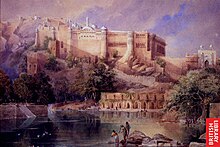



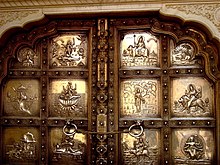
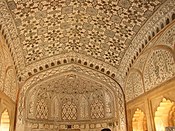






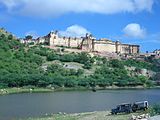

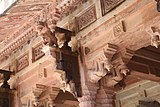




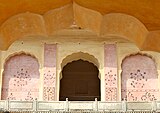



This Best Colleges in Jaipur for Arts, St. Wilfred’s, seems student-friendly and career-focused. But how’s the overall student-teacher interaction? Is it approachable or strictly formal?
ReplyDelete